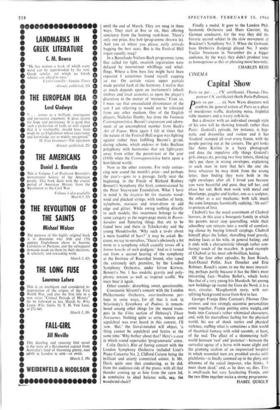MUSIC
N\ isp and \\ huffle
`TAKE care of the sense, and the sounds will rTtake care of themselves.' Lewis Carroll's pleasantry is elevated by some into an aesthetic principle. What does it matter whether a fugue be played on organ or piano, orchestra or string quartet? If well enough constructed. it will tell its noble tale equally well in any medium.
So runs the puritanical argument. I am not convinced. One thing is certain : ugly sounds, whether their ugliness arises fortuitously (from bad playing) or integrally (from bad scoring), are capable of turning musical sense into something pretty close to nonsense. In the light of these generalisations I turn to certain recent experi- ences at the Festival Hall.
First, those Wednesday organ recitals. Eleven programmes by nine organists, English or foreign, started in mid-January and continue
until the end of March. They are snug in three ways. They start at five to six, thus offering sanctuary from the homing rush-hour. There's only one price, five bob (programme thrown in). And you sit where you please, early arrivals bagging the best seats. But is the Festival Hall organ equally snug?
In a Buxtehude-Nielsen-Bach programme items that called for light, sweetish registration were defaced by intermittent whifffings and whuf- flings. Where a firm bass line might have been expected 1 sometimes found myself cupping an ear. On certain voices upper partials made painful hash of the harmony. I realise that as much depends upon an instrument's inbuilt timbres and local acoustics as upon the player's discretion in the matter of 'mixtures.' Even so, I must say that emasculated dissonances of the sort I am referring to would not be tolerated from any other medium. One of the English players, Nicholas Danby, has done the Fantasia Contrappuntistica, Busoni's expansion and adorn- ment of an uncompleted number from Bach's Art of Fugue. Here again I felt at times that the nature of the Festival Hall organ was fighting against rather than fulfilling Busoni's grand, daring scheme, which endows or links Bachian polyphony with harmonies that are light-years away from either the parent-text or the year (1910) when the Contrappuntistica burst upon a bewildered world.
Now to the other extreme. For truly entran- cing new sound the month's prize—and perhaps the year's—goes to a passage, fairly near the beginning, in the Finale of Richard Rodney Bennett's Symphony (his first), commissioned by the Peter Stuyvesant Foundation. What I have in mind is the leggiero bit for staccato wood- wind and plucked strings, with touches of harp, xylophone, maracas and tenor-drum to add edge and glitter. While owing nothing directly to such models, this sweetmeat belongs to the same category as the negro-page music in Rosen- kavalier and fluttering things that are to be found here and there in Tchaikovsky and the young Mendelssohn. 'Why such a to-do about a mere handful of bars?' it may be asked. Be- cause, we say to ourselves, 'There's obviously a lot more to a symphony which casually tosses off a bonne bouche of such pedigree.' And so it turned out from a second hearing of the symphony at the Institute of Recorded Sound, who taped the extremely deft premiere, by the London Symphony Orchestra, under Istvan Kertesz. Bennett's No. 1 has medolic gravity and poly- phonic tension as well as inspired soufflé. We must hear it again.
Other sounds: disturbing, sweet, questionable.
Constantin Silvestri's concert with the London Philharmonic Orchestra, over-toothsome per- haps in some ways, for all that it took in Stravinsky's Symphony of Psalms, is remem- bered among other things for the muted trum- pets in the Fêtes section of Debussy's Three Nocturnes. Nothing quite as eerie, remote and sepulchral was ever heard in this context, I'll vow. 'But,' the literal-minded will object, 'a thing cannot be sepulchral and festive at the same time.' Why bother about that? Here's a case in which sound supersedes 'programmatic' sense.
Colin Davis's Rite of Spring concert with the London Symphony Orchestra included Liszt's Piano Concerto No. 2, Clifford Curzon being the brilliant and utterly committed soloist. Is Mr. Davis quite sure that conducting, as he did, from the audience-side of the piano, with all that thunder coming up at him from the open lid, is conducive to ideal balance with, say, the woodwind choir? Finally a medal. It goes to the London Phil- harmonic Orchestra and Hans Gierster, the German conductor, for the way they did the historic second subject in the slow movement of Bruckner's Symphony No. 3. When the Gewand- haus Orchestra (Leipzig) played No. 3 under Vaclav Neumann in November (to a bigger audience, by the way), they didn't produce tone as homogenous as this or phrasing more heavenly.
CHARLES REID



































 Previous page
Previous page